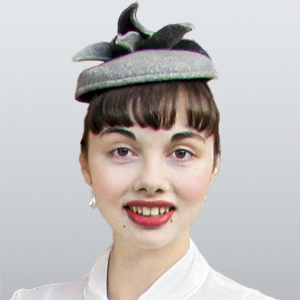Commentary
Hi. Hello. Hey. How are you? How do you do. How’s it going?
These are all common greetings in the English language. For some reason, they all begin with the letter “H.” These greetings vary in levels of formality. These days, the most common greetings, at least in my native California, are “Hi” or “Hey.” “Hello” sounds formal and old-fashioned.
It wasn’t always this way, however. “Hello” used to be a slang term which was reserved for very close relationships and originated in particular circumstances. This expression has a fascinating history, which involves Thomas Edison, Emily Post, and Giacomo Puccini.
The Beginning of Hello
The first recorded usage of the word “hello” is from 1826, when it was recorded as “hallo.” Other variations include spellings of “halloo,” “hullo,” “hollo,” and even “hillo.” All these words could be used as greetings or exclamations of surprise or discovery. There are much older examples of various spellings besides “hello,” in which the word is used as a call to attract attention, such as by hunters or mariners.
The word was used infrequently in daily life throughout the 19th century. It wasn’t until the invention of the telephone that its widespread use became common. Alexander Graham Bell originally proposed the word “Ahoy” to answer the phone, a word now usually linked with a nautical greeting.
However, Thomas Edison is given credit for making “hello” the accepted greeting. In 1877, he wrote to T. B. A. David of Pittsburgh’s Central District and Printing Telegraph Company, “I do not think we shall need a call bell, as Hello! can be heard 10 to 20 feet away.” A simple word like “hello” was preferable to a longer expression, such as “How do you do,” which would be used in face-to-face interactions. In addition, greetings would often include indicators of time, such as “Good morning,” “Good evening,” etc. They also would frequently include the other person’s name. When answering the phone, one may not know to whom he is speaking or where that person is located. As the word caught on, its usage with the telephone became so closely linked that by 1889, central telephone exchange operators were nicknamed “hello-girls.”
Perhaps because of its informality, some etiquette experts considered it inappropriate for use as a greeting in every situation. For instance, Emily Post wrote in her 1922 book “Etiquette”: “On very informal occasions, it is the present fashion to greet an intimate friend with ‘Hello!’ This seemingly vulgar salutation is made acceptable by the tone in which it is said. To shout ‘Hullow!’ is vulgar, but ‘Hello, Mary’ or ‘How ‘do, John,’ each spoken in an ordinary tone of voice, sound much the same. But remember that the ‘Hello’ is spoken, not called out, and never used except between intimate friends who call each other by the first name.” Of course, in those days, people didn’t address casual acquaintances, business associates, and people they had just met by first name.
A Musical Hello
There are many songs which feature the word “hello” prominently in the lyrics and title. The more recent ones have nothing to do with the telephone. However, a few early ones were based on the newfound popularity of this word. In 1899, the Tin Pan Alley songwriting team of Howard and Emerson wrote a song called “Hello! Ma Baby,” which is about a man with a sweetheart whom he only knows by telephone. The telephone was still a new commodity, so this popular song capitalized on the newfangled technology and the greeting commonly associated with it.
In 1915, the first wireless telephone transmission from the continental United States (Virginia) to Hawaii inspired another telephone-themed song, “Hello, Hawaii, How Are You?” This tune by Jean Schwartz, Bert Kalmar, and Edgar Leslie is about a man in New York who spends “a whole month’s pay” to talk to “Honolulu Lou” on the telephone.
It was predictable that comical popular tunes from Tin Pan Alley would satirize the newly popularized greeting, but there are also two notable operas which feature the word “hello” very prominently. Both were written in the 20th century by Italian composers but set in America, although one is in Italian and the other is in English. The Italian opera is “The Girl of the Golden West” (“La Fanciulla del West”) by Giacomo Puccini. Inspired by his visit to America in 1907 to see the Metropolitan Opera premiere of his opera “Madama Butterfly,” it was based on the David Belasco play of the same name.
This grand Italian opera is set in the Wild West during the Gold Rush, and its libretto (sung text) features an eclectic mix of English words and American colloquialisms sprinkled throughout. The opera begins with the local miners coming into the town saloon and greeting the bartender and each other with shouted and sung exclamations of “Hello!” Puccini and his librettist, Giacomo Veri, relied on stereotypes to paint this colorful picture of America’s recent past, and this included the idiomatic greeting.
Interestingly, the libretto reflects the standards which Emily Post recounted, about when to use the word. It’s “Hello” when the miners greet each other, the bartender, and the female saloon keeper by first name, but it’s “Buona serra” (“Good evening”) when greeting newcomer Mister Johnson.
The other opera is “The Telephone,” a 1945 one-act chamber opera by Gian-Carlo Menotti. Despite the composer’s Italian name and birth, he was an American citizen by this point, writing his own libretti for his operas. This two-person opera is about a man whose proposal attempts are constantly thwarted by his sweetheart’s incessant talking on the telephone. She sings “Hello” every time she answers the phone. In fact, her main aria is called, “Hello? Hello? Oh, Margaret, It’s You.”
It’s fascinating to study the history of speech and the complexity of language. What’s an idiom today may be formal speech tomorrow.













